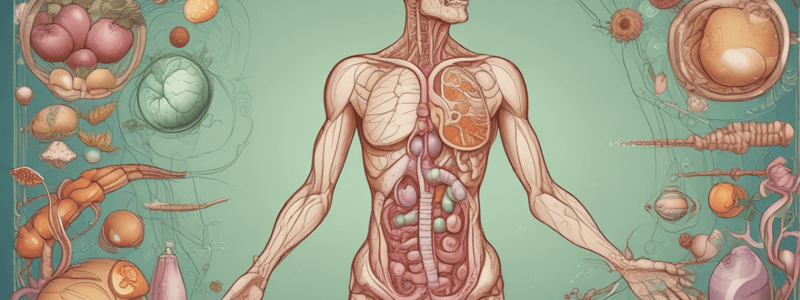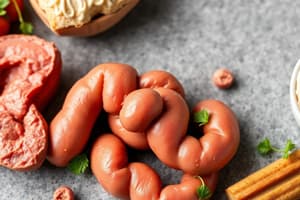Podcast
Questions and Answers
What is the role of DNA in the synthesis of proteins in the human body?
What is the role of DNA in the synthesis of proteins in the human body?
DNA provides the information for cells to assemble amino acids in specific sequences to make proteins.
Describe the process by which cells assemble amino acids into proteins.
Describe the process by which cells assemble amino acids into proteins.
Cells assemble amino acids into proteins by linking them together in specific sequences according to the information provided by DNA.
What is the significance of the 20 amino acids in protein synthesis?
What is the significance of the 20 amino acids in protein synthesis?
The 20 amino acids are the building blocks of proteins, and their specific sequences determine the structure and function of the protein.
How can the proteins in a sample of blood be used to determine their origin?
How can the proteins in a sample of blood be used to determine their origin?
What happens to excess amino acids in the body?
What happens to excess amino acids in the body?
Describe the concept of nitrogen balance.
Describe the concept of nitrogen balance.
How do cells use DNA to synthesize proteins?
How do cells use DNA to synthesize proteins?
What is the significance of protein synthesis in the human body?
What is the significance of protein synthesis in the human body?
What is the chemical attraction that connects amino acids to form a chain?
What is the chemical attraction that connects amino acids to form a chain?
What is the minimum number of amino acids required to form a polypeptide?
What is the minimum number of amino acids required to form a polypeptide?
What is the role of mRNA in protein synthesis?
What is the role of mRNA in protein synthesis?
What is the purpose of tRNA in protein synthesis?
What is the purpose of tRNA in protein synthesis?
What happens when a diet lacks one or more essential amino acids?
What happens when a diet lacks one or more essential amino acids?
What is the term for small chains of amino acids that usually contain fewer than 15 amino acids?
What is the term for small chains of amino acids that usually contain fewer than 15 amino acids?
What is the primary function of ribosomes in protein synthesis?
What is the primary function of ribosomes in protein synthesis?
What is the term for the process of forming a peptide bond between two amino acids, releasing a molecule of water?
What is the term for the process of forming a peptide bond between two amino acids, releasing a molecule of water?
What is the significance of collagen in the human body?
What is the significance of collagen in the human body?
Why may dietary supplements containing collagen hydrolysates (CHs) not guarantee collagen production in the body?
Why may dietary supplements containing collagen hydrolysates (CHs) not guarantee collagen production in the body?
Where does the chemical digestion of protein begin?
Where does the chemical digestion of protein begin?
What enzymes break down polypeptides into shorter peptides and amino acids in the small intestine?
What enzymes break down polypeptides into shorter peptides and amino acids in the small intestine?
What is the end product of protein digestion?
What is the end product of protein digestion?
Why can cells not distinguish the source of amino acids?
Why can cells not distinguish the source of amino acids?
What is protein turnover, and what is its significance?
What is protein turnover, and what is its significance?
What is the main site of nonessential amino acid production in the human body?
What is the main site of nonessential amino acid production in the human body?
What are some potential benefits of taking oral collagen supplements, according to scientific studies?
What are some potential benefits of taking oral collagen supplements, according to scientific studies?
What is the purpose of deamination, and what is the resulting product?
What is the purpose of deamination, and what is the resulting product?
What determines the three-dimensional shape of a protein?
What determines the three-dimensional shape of a protein?
What happens to the nitrogen-containing group removed during deamination?
What happens to the nitrogen-containing group removed during deamination?
What happens when the wrong amino acid is introduced into the amino acid chain during protein synthesis?
What happens when the wrong amino acid is introduced into the amino acid chain during protein synthesis?
What is the end product of transamination, and what is its significance?
What is the end product of transamination, and what is its significance?
What is the result of sickle cell anemia, a genetic disorder that affects hemoglobin?
What is the result of sickle cell anemia, a genetic disorder that affects hemoglobin?
What is the fate of excess ammonia in the bloodstream?
What is the fate of excess ammonia in the bloodstream?
What is protein denaturation, and what causes it?
What is protein denaturation, and what causes it?
What is the purpose of denaturation in cooking and food preparation?
What is the purpose of denaturation in cooking and food preparation?
What happens to proteins in milk when acidic lemon juice is added?
What happens to proteins in milk when acidic lemon juice is added?
What is the role of hydrochloric acid in the stomach?
What is the role of hydrochloric acid in the stomach?
Why must large proteins in foods be digested before absorption?
Why must large proteins in foods be digested before absorption?
What is the relationship between protein shape and function?
What is the relationship between protein shape and function?
What is the primary function of the kidneys in regards to waste elimination?
What is the primary function of the kidneys in regards to waste elimination?
What happens to the carbon skeletons of deaminated amino acids in the liver?
What happens to the carbon skeletons of deaminated amino acids in the liver?
What are the primary sources of nitrogen loss in the human body?
What are the primary sources of nitrogen loss in the human body?
What is the purpose of hormones like insulin, growth hormone, and testosterone in regards to nitrogen balance?
What is the purpose of hormones like insulin, growth hormone, and testosterone in regards to nitrogen balance?
What is the Estimated Average Requirement (EAR) for protein in healthy adults?
What is the Estimated Average Requirement (EAR) for protein in healthy adults?
How does weight (resistance) training affect nitrogen balance?
How does weight (resistance) training affect nitrogen balance?
What is the recommended daily protein intake for a healthy adult?
What is the recommended daily protein intake for a healthy adult?
What happens to the body when it is in a state of negative nitrogen balance?
What happens to the body when it is in a state of negative nitrogen balance?
What is the purpose of the Recommended Dietary Allowance (RDA) for protein?
What is the purpose of the Recommended Dietary Allowance (RDA) for protein?
How can you determine your daily protein needs?
How can you determine your daily protein needs?
Flashcards are hidden until you start studying
Study Notes
Protein Synthesis
- The body makes proteins by following information coded in DNA
- Cells assemble the 20 amino acids in specific sequences according to DNA instructions
- Proteins are made up of amino acid "beads" connected by peptide bonds
- A polypeptide forms when two or more amino acids join to form a chain
- The shape of a protein is important because it influences the compound's activity in the body
Steps of Protein Synthesis
- DNA in the cell's nucleus contains the information for making proteins
- A section of the DNA double helix unwinds, exposing a gene
- Messenger RNA (mRNA) is formed by transcription
- mRNA leaves the nucleus and moves to ribosomes in the cytoplasm
- Ribosomes translate the gene's coded instructions for adding amino acids to the polypeptide chain
- Transfer RNA (tRNA) conveys specific amino acids to the ribosomes
- The amino acid from tRNA is added to the last amino acid, causing the peptide chain to grow longer
- After the mRNA is read completely, the ribosome releases the polypeptide
Importance of Protein Synthesis
- Diets that contain low-quality protein can result in poor growth, slowed recovery from illness, and even death
- Protein synthesis in cells cannot proceed when the supply of amino acids does not have one or more of the essential amino acids needed for constructing the polypeptide chain
Protein Denaturation
- A protein undergoes denaturation when it is exposed to various conditions that alter its natural folded and coiled shape
- Denaturation can occur through heat, acid, or other treatments
- Denaturation does not "kill" a protein, but permanently alters its shape and function
Protein Digestion and Absorption
- The chemical digestion of protein begins in the stomach, where hydrochloric acid denatures food proteins and pepsin digests proteins into smaller polypeptides
- In the small intestine, protein-splitting enzymes, including trypsin and chymotrypsin, break down polypeptides into shorter peptides and amino acids
- Enzymes released by the absorptive cells of the small intestine break down most of the shortened peptides into dipeptides, tripeptides, and individual amino acids
- Amino acids are absorbed into the bloodstream and transported to the liver
- The liver distributes the amino acids to other cells, which use them to make human proteins
Nitrogen Balance
- The body conserves nitrogen by recycling amino acids
- Nitrogen intake and protein turnover must balance with nitrogen losses
- Positive nitrogen balance occurs during periods of rapid growth, recovery from illness or injury, and pregnancy
- Negative nitrogen balance occurs during starvation, serious illnesses, and severe injuries
Protein Turnover
- Protein turnover is the process of breaking down old or unneeded proteins into their component amino acids and recycling them to make new proteins
- The amino acid pool is an endogenous, or internal, source of nitrogen
- The body obtains about two-thirds of its amino acid supply from endogenous sources and the remainder from exogenous (dietary) sources
Studying That Suits You
Use AI to generate personalized quizzes and flashcards to suit your learning preferences.




